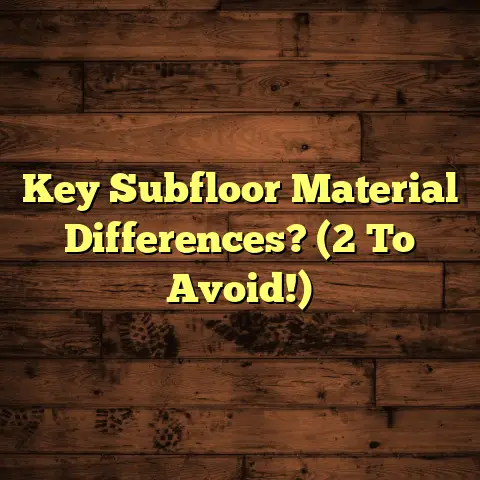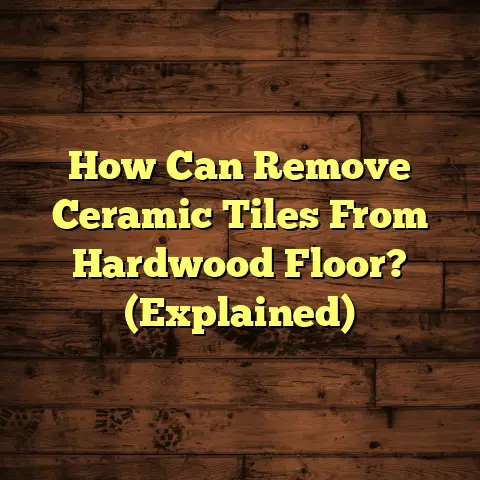Wheelchair Flooring Access: Explained! (1 Key Factor)
Think about it: a smooth, easily navigable floor can mean the difference between someone confidently moving through their home or struggling with every turn. That’s why I’m so passionate about this topic.
In this article, we’re diving deep into wheelchair flooring access, and I’m going to let you in on a game-changing material I’ve been working with more and more: Polyurethane Resilient Flooring (PRF).
We’re talking durability, slip-resistance, easy cleaning, and a whole lot more. So, buckle up, and let’s get started!
Section 1: Understanding Wheelchair Flooring Access
Okay, so what exactly is wheelchair flooring access? Simply put, it’s about ensuring that flooring doesn’t hinder a wheelchair user’s ability to move freely and safely through a space.
It’s about minimizing resistance, preventing slips, and creating a surface that’s comfortable and predictable. It’s also about creating a safe and inclusive environment.
Why is this so important? Well, imagine trying to maneuver a wheelchair over thick carpet, uneven tiles, or a slippery surface. It’s exhausting, frustrating, and potentially dangerous.
Inclusivity is Key.
Wheelchair flooring access is about more than just physical mobility; it’s about fostering inclusivity in our homes, workplaces, and public spaces.
It’s about ensuring that everyone has the opportunity to participate fully in society, without being limited by their environment.
The ADA and Flooring.
Now, let’s talk about the elephant in the room: the Americans with Disabilities Act (ADA). This landmark legislation sets accessibility standards for public accommodations and commercial facilities. While it doesn’t specifically dictate which flooring to use, it outlines crucial requirements that flooring must meet.
These include:
- Slip Resistance: Floors must have a high coefficient of friction to prevent slips and falls.
- Level Surfaces: Changes in level must be minimized and clearly marked.
- Stable and Firm Surfaces: Floors must be stable and firm to provide a solid base for wheelchairs.
- Minimal Gaps: Gaps and openings in the flooring must be small enough to prevent wheelchair wheels from getting caught.
I’ve seen firsthand how failing to meet these standards can create significant barriers for wheelchair users. It’s not just about ticking boxes; it’s about creating spaces that are truly accessible and welcoming.
Section 2: The Unique Material –
Polyurethane Resilient Flooring
Alright, now for the star of the show: Polyurethane Resilient Flooring (PRF)! I’ve been seriously impressed with this stuff. It’s not your grandma’s linoleum.
Let’s break down what makes PRF so special:
Composition
PRF is a synthetic flooring made from polyurethane, a polymer known for its durability, flexibility, and resistance to wear and tear. It typically consists of multiple layers, including:
- Wear Layer: The top layer, designed to withstand heavy traffic and resist scratches, stains, and abrasions.
- Design Layer: A printed layer that provides the flooring’s aesthetic appeal, offering a wide range of colors, patterns, and textures.
- Core Layer: A dense, resilient layer that provides cushioning and support.
- Backing Layer: A layer that provides stability and helps to bond the flooring to the subfloor.
How Does It Stack Up?
Compared to traditional flooring options like tile, carpet, or vinyl, PRF offers some distinct advantages:
| Feature | PRF | Tile | Carpet | Vinyl |
|---|---|---|---|---|
| Durability | High | High | Moderate | Moderate |
| Slip Resistance | Excellent | Variable (can be slippery) | Good (depending on pile) | Good (can be slippery when wet) |
| Maintenance | Easy | Moderate | Difficult | Easy |
| Comfort | Excellent (cushioned) | Poor (hard) | Good (soft) | Moderate |
| Wheelchair Use | Excellent | Good | Poor (high resistance) | Good |
| Cost | Moderate to High | Moderate to High | Moderate | Low to Moderate |
Benefits
Here’s where PRF really shines, especially for wheelchair users:
- Shock Absorption: PRF’s resilient nature provides excellent shock absorption, reducing the impact on joints and minimizing fatigue for wheelchair users. This is huge for long-term comfort and health.
- Reduced Strain: The smooth, low-resistance surface of PRF makes it easier to propel a wheelchair, reducing strain on the arms and shoulders.
- Enhanced Mobility: PRF’s slip-resistant surface provides excellent traction, even when wet, improving mobility and reducing the risk of accidents.
- Easy to Clean: PRF is incredibly easy to clean and maintain, requiring only regular sweeping and occasional mopping. This is a major plus for accessibility, as it minimizes the need for harsh chemicals or specialized cleaning equipment.
- Durability: PRF is highly resistant to scratches, stains, and wear and tear, making it a long-lasting and cost-effective flooring solution.
Variety of Designs
One of the things I love about PRF is its versatility. It’s available in a wide range of colors, patterns, and finishes, so you can create a space that’s both functional and aesthetically pleasing.
You can find PRF that mimics the look of wood, stone, or tile, or opt for bold, modern designs that make a statement. The possibilities are endless!
I’ve used PRF in everything from hospitals and schools to private homes, and I’m always amazed at how well it complements different design schemes while maintaining its functionality.
Section 3: Case Studies and Real-World Applications
Let’s get into some real-world examples of how PRF is making a difference in accessibility.
Schools:
I recently worked on a project for a local elementary school that was looking to improve accessibility in its hallways and classrooms. We installed PRF throughout the school, and the results were remarkable.
Teachers reported that students using wheelchairs were able to move more easily and independently, and the overall atmosphere of the school felt more inclusive and welcoming.
Hospitals:
Hospitals are another area where PRF can make a huge difference. I’ve seen firsthand how PRF can reduce noise levels, improve hygiene, and create a more comfortable environment for patients and staff alike.
One hospital I worked with installed PRF in its rehabilitation center, and patients reported that it made it easier to participate in therapy sessions and move around the facility.
Shopping Centers:
Shopping centers are often challenging environments for wheelchair users, with crowded aisles, uneven surfaces, and slippery floors. PRF can help to create a safer and more accessible shopping experience.
I’ve worked on several shopping center projects where we installed PRF in high-traffic areas, and the feedback from shoppers and store owners has been overwhelmingly positive.
Testimonials:
But don’t just take my word for it. Here are some testimonials from wheelchair users and facility managers who have experienced the benefits of PRF firsthand:
- “The PRF flooring in my office has made a huge difference in my daily life. It’s so much easier to move around, and I don’t feel as tired at the end of the day.” – Sarah, Office Worker
- “We installed PRF in our school to improve accessibility for our students with disabilities. It’s been a game-changer. The students are more independent, and the staff are less stressed.” – John, School Principal
- “PRF is the perfect flooring solution for our
hospital. It’s durable, easy to clean, and provides
a safe and comfortable environment for our patients.”
- Mary, Hospital Administrator
Section 4: Challenges and Limitations of
Wheelchair Flooring Access
Okay, let’s be real. No flooring solution is perfect, and PRF is no exception. There are some challenges and limitations to consider when it comes to wheelchair flooring access.
Installation:
Proper installation is absolutely crucial for the effectiveness of PRF. If it’s not installed correctly, it can lead to uneven surfaces, gaps, and other issues that can hinder wheelchair mobility.
I always recommend hiring a qualified and experienced flooring contractor who is familiar with PRF installation techniques.
Maintenance:
While PRF is relatively easy to maintain, it’s important to follow the manufacturer’s recommendations for cleaning and maintenance. Avoid using harsh chemicals or abrasive cleaners, as they can damage the flooring’s surface.
Cost:
PRF can be more expensive than some other flooring options, such as vinyl or carpet. However, its durability and long lifespan can make it a cost-effective solution in the long run.
Potential for Damage:
While PRF is durable, it’s not indestructible. Sharp objects or heavy impacts can damage the flooring’s surface. It’s important to take precautions to protect the flooring from damage, such as using floor mats in high-traffic areas.
Section 5: Future Trends in Wheelchair Flooring Access
The world of flooring is constantly evolving, and I’m excited about the future of wheelchair flooring access. Here are some emerging trends to keep an eye on:
Smart Flooring:
Imagine flooring that can detect falls, monitor gait, and provide real-time feedback to caregivers. Smart flooring technology is becoming increasingly sophisticated, and it has the potential to revolutionize accessibility for wheelchair users.
Sustainable Materials:
As sustainability becomes more important, I expect to see more flooring options made from recycled or renewable materials. This is a win-win for the environment and for accessibility.
Adaptive Flooring:
Adaptive flooring is designed to adjust to the needs of different users. For example, it might change its texture or color to provide visual cues for people with low vision.
Integration with Assistive Technology:
I believe that flooring will become increasingly integrated with assistive technology, such as smart home systems and wearable devices. This could lead to more personalized and seamless accessibility solutions.
Conclusion
Choosing the right flooring is a critical decision, especially when it comes to wheelchair access. Polyurethane Resilient Flooring (PRF) offers a unique combination of durability, slip-resistance, ease of cleaning, and aesthetic appeal that can transform spaces for wheelchair users.
By prioritizing accessibility in our designs, we can create more inclusive and welcoming communities for everyone.
I hope this article has given you a better understanding of wheelchair flooring access and the benefits of PRF. If you have any questions or would like to learn more, please don’t hesitate to reach out.
Let’s work together to create a world where everyone can move freely and safely.





